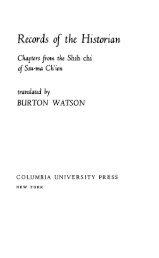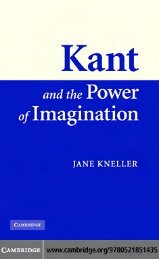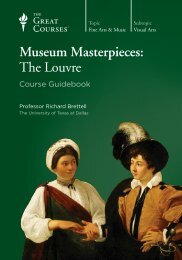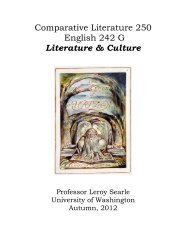Ellipsis of Battle.pdf - University of Washington
Ellipsis of Battle.pdf - University of Washington
Ellipsis of Battle.pdf - University of Washington
You also want an ePaper? Increase the reach of your titles
YUMPU automatically turns print PDFs into web optimized ePapers that Google loves.
32<br />
Journal <strong>of</strong> the American Oriental Society 95.1 (1975)<br />
ries <strong>of</strong> the battle. Whereas the sacrifice to heaven,<br />
mountains, rivers, and ancestors ritualistically<br />
completes the formal conquest, a happy wedding<br />
in remembrance marks the end <strong>of</strong> this poem<br />
about a commoner's war experience. Poem 156<br />
likewise ends with a personal emphasis on the rite.<br />
The specific ritual program, the wedding, is com-<br />
patible with the circumstances under which the<br />
singer expresses his love and piety. As the merits<br />
<strong>of</strong> the Duke <strong>of</strong> Chou signify the d6nouement <strong>of</strong><br />
the Weniad, poem 156, a part <strong>of</strong> the national epic,<br />
reiterates all the more forcefully the distinctive<br />
meaning <strong>of</strong> heroism in the founding and protection<br />
<strong>of</strong> the empire. The plentitude <strong>of</strong> an epic seems to<br />
congeal at a point where the rite occurs to settle<br />
the hero's adventures. The Iliad concludes with<br />
the burial <strong>of</strong> Hector, the famous breaker <strong>of</strong> horses,<br />
the Beowulf ends with the funeral <strong>of</strong> the aged<br />
hero, son <strong>of</strong> Ecgtheow and lord <strong>of</strong> the Geats,<br />
so does the Weniad have the apocalypse revealed<br />
in a certain ceremony that gives rise to and per-<br />
petuates music, rite, and agriculture.<br />
4. DEGENERATION OF A BIRD<br />
The ellipsis <strong>of</strong> battle as a poetic device in early<br />
Chinese literature seems to be a positive response<br />
to the urge that arms be concealed. The poet<br />
contrasts his emotions going to and coming back<br />
from the war, intensified by the change <strong>of</strong> seasons<br />
and natural objects, to heighten the dramatic<br />
tension <strong>of</strong> the passage <strong>of</strong> time. The war itself is<br />
omitted from the verse. By the contrast and<br />
juxtaposition <strong>of</strong> a concatenation <strong>of</strong> events, a<br />
chain <strong>of</strong> actions and reactions, the poet elicits an<br />
understanding <strong>of</strong> the horror <strong>of</strong> war from the imag-<br />
ination and collective experience<br />
<strong>of</strong> his audience.<br />
The interplay <strong>of</strong> the described moments before<br />
and after the war produces a highly developed<br />
event that becomes conceivably vivid with the<br />
audience.<br />
The convention prevailing in the style <strong>of</strong> the<br />
oral-formulaic poetry <strong>of</strong> Shih Ching continues to<br />
characterize Chinese poetry in the subsequent<br />
periods.36 Within a small scope <strong>of</strong> composition, it<br />
36 The poetry <strong>of</strong> Shih Ching is presumably oral and<br />
demonstrably formulaic. For a study <strong>of</strong> this aspect <strong>of</strong><br />
ancient Chinese poetry, see C. H. Wang, The Bell and<br />
the Drum: Shih Ching as Formulaic Poetry in an Oral<br />
Tradition (Berkeley: <strong>University</strong> <strong>of</strong> California Press,<br />
1974); for a definition <strong>of</strong> the formula in terms <strong>of</strong> oral<br />
poetry, see Chapter Two.<br />
always presents a certain symmetrical structure<br />
that defines the unsaid. The unsaid, moreover,<br />
is flanked by the two contrasting, concatenate<br />
elements which seem to comprise a couplet,<br />
perhaps the origin <strong>of</strong> the antithetical parallel<br />
structure <strong>of</strong> Chinese poetry. An example follows:<br />
a-1. hsi wo wang yi<br />
(long) ago [when] I left yi (particle)<br />
a-2. yang liu yi yi<br />
poplars [and] willows [were] dangling [and] dang-<br />
ling<br />
b-1. chin wo lai ssu<br />
now [as] I return ssu (particle)<br />
b-2. yii hsiieh fei feix<br />
rain [and] snow [are] flying [and] flying<br />
The adventure is defined only suggestively between<br />
a (1-2) and b(1-2). In an oral tradition the formula<br />
a(b)-1 is powerful enough to achieve a certain<br />
totality <strong>of</strong> association which the poet aims at for<br />
his audience. The ellipsis is also evident in other<br />
contexts. The elegies from Ch'u Tz'u, for<br />
example, abound in the uses <strong>of</strong> the contrast <strong>of</strong><br />
morning and evening in two successive lines.37<br />
Many other poems from the Han era conform to<br />
this convention; <strong>of</strong> them the most salient one is<br />
the yiieh-fu "Fighting South <strong>of</strong> the Walls." Here<br />
the poet again uses the contrast <strong>of</strong> places (south<br />
vs. north) and <strong>of</strong> moments (morning vs. evening)<br />
to convey the horror <strong>of</strong> the war in a perfect an-<br />
tithetical structure. The contrast <strong>of</strong> places opens<br />
the poem, while the contrast <strong>of</strong> moments closes<br />
it. The lines in the middle are devoted to the cor-<br />
relative objects and to some eulogistic observations<br />
the poet has.38 The similar technique is used in the<br />
"Ballad <strong>of</strong> Mu-lan" ("Mu-lan tz'u"),Y usually<br />
dated in the third or fourth century. Of the in-<br />
stances in this song, the following couplets show<br />
the most distinctive development <strong>of</strong> the ellipsis<br />
<strong>of</strong> battle in a single composition. Mu-lan decided<br />
to dress as a man to go to the war on behalf <strong>of</strong><br />
her old father.<br />
At dawn she parted from her parents:<br />
At dusk she encamped by the Yellow River.<br />
37 See "Li sao" and "Hsiang fu-jen" (for translations<br />
see David Hawkes, Ch'u Tz'u: The Songs <strong>of</strong> the South<br />
[Boston, 1959], pp. 21-34, 38-39).<br />
38 For a translation and interpretation <strong>of</strong> this poem,<br />
see Hans H. Frankel, "The Abduction, the War, and the<br />
Desperate Husband: Three Early Chinese Ballads," Ven-<br />
tures, 5. 1 (1965), 9-12.







